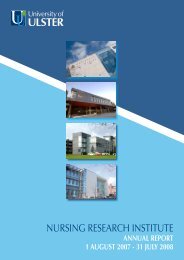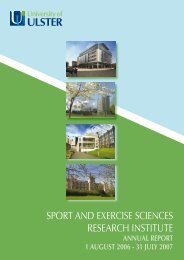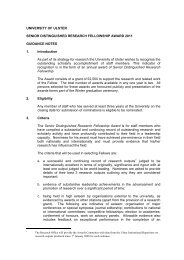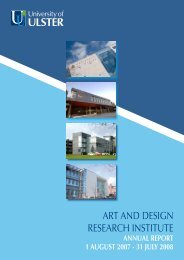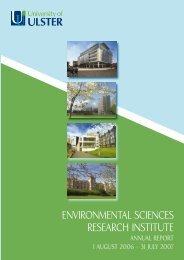11. SYSTEMS BIOLOGY RESEARCH GROUPThe strategy <strong>of</strong> the Systems Biology <strong>Research</strong> Group (SBRG) is focused on the bioinformatics and computationalelements <strong>of</strong> the now strongly growing interdisciplinary field <strong>of</strong> systems biology. Systems biology is defined as “thequantitative analysis <strong>of</strong> the dynamic interactions between several components <strong>of</strong> a biological system and aims to understand thebehaviour <strong>of</strong> the system as a whole. It applies the concepts and methodologies <strong>of</strong> systems theory and engineering to the study<strong>of</strong> complex biological systems through iteration between computational and mathematical modelling and experimentation.Systems Biology is a tool to increase understanding <strong>of</strong> the system, to develop more directed experiments and finally allowpredictions”.This strategic view on the Group’s <strong>research</strong> aligns well with national and international priorities. Complementing this<strong>research</strong> strategy, academic members <strong>of</strong> the Group are currently in the process to develop a basic teaching coursein systems biology. As personalized medicine seems to find its way into national and international <strong>research</strong> agendas,first steps have been taken to explore this dimension in the context <strong>of</strong> systems biology.The main <strong>research</strong> themes investigated by the SBRG, include modelling <strong>of</strong> interactions in kinase/phosphatase systems;modelling and simulation <strong>of</strong> gene regulatory networks; qualitative modelling <strong>of</strong> the bile acid and xenobiotic system;computational study <strong>of</strong> the genetic causes <strong>of</strong> LQT syndrome; and various aspects <strong>of</strong> management and analysis <strong>of</strong>biological information.In the reporting period, members <strong>of</strong> the Group published a considerable number <strong>of</strong> articles in high-calibre internationaljournals and conferences (some <strong>of</strong> which were included in the 2008 RAE submission) and was awarded considerablelevels <strong>of</strong> <strong>research</strong> grants. The Group has also consolidated its <strong>research</strong> partner network nationally and internationally,including renowned organizations such as the <strong>University</strong> <strong>of</strong> Queensland, Brisbane, Australia; the Haifa Institute <strong>of</strong>Technology, Israel; Korea Advanced Institute <strong>of</strong> Science and Technology (KAIST), Republic <strong>of</strong> Korea. Some members<strong>of</strong> the Group have been members <strong>of</strong> international advisory boards and journal editorial boards.The Group has 5 dual processor servers that provide Web services and content-management s<strong>of</strong>tware, groupware,file and database services (Oracle Enterprise server 10G) as well as Grid services (Globus and CONDOR). Forlarge-scale computing tasks, there is a 64-way Itanium Altix 3700 supercomputer with 128GB <strong>of</strong> addressable memoryand 8 TB <strong>of</strong> disk storage. Projects using this system range from protein-unfolding simulations to tracing <strong>of</strong> stainedstructures in large image stacks.98
MEMBERS OF THE GROUPPr<strong>of</strong>essor Werner Dubitzky, Group LeaderPr<strong>of</strong>essor <strong>of</strong> BioinformaticsContact details:T: +44 (0)28 70324478w.dubitzky@ulster.ac.ukPr<strong>of</strong>essor Dubitzky’s main <strong>research</strong> activities in the reporting period included:• preparation <strong>of</strong> <strong>research</strong> papers for RAE 2008;• preparation <strong>of</strong> <strong>research</strong> grant applications;• <strong>research</strong> in modelling, analyzing and simulating <strong>biomedical</strong> systems;• working on new edited volumes (books and special issues in international journals and an encyclopedia);• management and <strong>research</strong> on ongoing <strong>research</strong> projects;• networking.The key themes <strong>of</strong> Werner’s <strong>research</strong> activities in this reporting period revolved around computational elements<strong>of</strong> systems biology and e-science (which are both part <strong>of</strong> national and European <strong>research</strong> priorities). These themeswill continue to be his <strong>research</strong> focus into the future, perhaps with a stronger element <strong>of</strong> personalized medicine,dynamical modelling and integration <strong>of</strong> heterogeneous information for modelling and simulation <strong>of</strong> biological systemsand scientific knowledge discovery.Publications:Romberg M, Benfenati E & Dubitzky W; Open Computing Grid for Molecular Sciences in E-G. Talbi & A. Zomaya(editors), Grids for Bioinformatics and Computational Biology, Wiley Book Series on Parallel and Distributed Computing;John Wiley & Sons, New York, pp1-22. ISBN: 978-0-471-78409-8, 2007Cashman KD, Hill TR, Cotter AA, Boreham CA, Dubitzky W, Murray L, Strain J, Flynn A, Robson PJ, Wallace JM & KielyM; Low vitamin D status adversely affects bone health parameters in adolescents, American Journal <strong>of</strong> Clinical Nutrition,87: 1039-1044, 2008Fuß H, Dubitzky W, Downes CS & Kurth MJ; Src family kinases and receptors: analysis <strong>of</strong> three activation mechanismsby dynamic systems modelling; Biophysical Journal, 94, 1995-2006, 2008Hill TR, Cotter AA, Mitchell S, Boreham CA, Dubitzky W, Murray L, Strain JJ, Flynn A, Robson PJ, Wallace JM, Kiely M& Cashman KD; Vitamin D status and its determinants in adolescents from the Northern Ireland Young Hearts 2000cohort; British Journal <strong>of</strong> Nutrition, 99: 1061-1067, 2008Kravtsov V, Schuster A, Carmeli D, Kurowski K & Dubitzky W; Grid-enabling complex system applications withQosCosGrid: An architectural perspective, in Proceedings <strong>of</strong> the International Conference on Grid Computing andApplications (GCA'08), Las-Vegas, USA, 2008Kravtsov V, Carmeli D, Dubitzky W, Orda A, Schuster A, Silberstein M & Yoshpa B; Quasi-Opportunistic Supercomputingin Grid Environments, in Proceedings <strong>of</strong> the International Conference on Algorithms and Architectures, Cyprus, 233-244,2008Kravtsov V, Swain M, Dubin U, Dubitzky W & Schuster A; A Fast and Efficient Algorithm for Topology-AwareCoallocation, in Proceedings <strong>of</strong> the International Conference on Computational Science, Krakow, Poland, 274-283, 200899
- Page 1:
BIOMEDICAL SCIENCESRESEARCH INSTITU
- Page 4 and 5:
1 Foreword by the Pro Vice-Chancell
- Page 6 and 7:
2 Foreword by the Research Institut
- Page 8 and 9:
The BMSRI Research StructureThe BMS
- Page 10 and 11:
BMSRI Core FacilitiesContact: Karen
- Page 12 and 13:
of Metabolomics, pharmacy, nutritio
- Page 14 and 15:
BMSRI Academic Heads new Regional N
- Page 16 and 17:
4. BIOMEDICAL GENOMICS RESEARCH GRO
- Page 18 and 19:
Recent Funding Initiatives:C-TRIC:
- Page 20 and 21:
Dr Mateus Webba da SilvaLecturer in
- Page 22 and 23:
5. BIOIMAGING RESEARCH GROUPResearc
- Page 24 and 25:
developmental alterations that mani
- Page 26 and 27:
Publications:Bigot S, Lucas L, Morr
- Page 28 and 29:
Publications:Barnes CA, O’Hagan B
- Page 30 and 31:
We also measure the genotoxic effec
- Page 32 and 33:
6. CANCER AND AGEING RESEARCH GROUP
- Page 34 and 35:
Professor Anthony P McHaleProfessor
- Page 36 and 37:
Professor Stephanie McKeownProfesso
- Page 38 and 39:
an Alzheimer Research Trust collabo
- Page 40 and 41:
JM, Waugh DJJ; Dexamethasone potent
- Page 42 and 43:
have wider applications in vivo, in
- Page 44 and 45:
Inter-relationships between diet an
- Page 46 and 47:
Flatt PR; Effective surgical treatm
- Page 48 and 49:
These areas are the subject of seve
- Page 50 and 51: Dr YHA Abdel-WahabSenior Lecturer i
- Page 52 and 53: Dr VA GaultLecturer in Molecular Bi
- Page 54 and 55: McClean PL, Irwin N, Hunter K, Gaul
- Page 56 and 57: Publications:Duffy NA, Green BD, Ir
- Page 58 and 59: 8. MICROBIOLOGY AND BIOTECHNOLOGYRE
- Page 60 and 61: Publications:Graham RJL, Graham C,
- Page 62 and 63: analyses. However there is still a
- Page 64 and 65: Plessas S, Bekatorou A, Koutinas AA
- Page 66 and 67: Biochemical studies/ viral evasion
- Page 68 and 69: Dr Stephen McCleanLecturer in Prote
- Page 70 and 71: environmental remediation and as ro
- Page 72 and 73: 9. NORTHERN IRELAND CENTRE FOR FOOD
- Page 74 and 75: 26-28 Sept 2007: International Seaf
- Page 76 and 77: Dr Barnes has developed expertise i
- Page 78 and 79: Dr Alison GallagherSenior Lecturer
- Page 80 and 81: In addition, results of a pilot stu
- Page 82 and 83: Dr Maeve KerrResearch AssociateCont
- Page 84 and 85: Memberships of External Committees/
- Page 86 and 87: Indicators of Esteem:Professor McNu
- Page 88 and 89: were examined. The intervention and
- Page 90 and 91: Within this work both short-term an
- Page 92 and 93: micronutrient supplementation at a
- Page 94 and 95: 10. STEM CELL & EPIGENETICS RESEARC
- Page 96 and 97: Publications:Lees-Murdock DJ, Lau H
- Page 98 and 99: Publications:Lees-Murdock DJ, Lau H
- Page 102 and 103: Kravtsov V, Swain M, Schuster A, Du
- Page 104 and 105: Dr Daniel BerrarLecturer in Biomedi
- Page 106 and 107: Zhang et al; Incorporating Feature
- Page 108 and 109: Bala P, Baldridge K, Benfenati E, C
- Page 110 and 111: In addition there is a growing them
- Page 112 and 113: Clinical work involves development
- Page 114 and 115: In 2009 he was appointed Chairman o
- Page 116 and 117: Stevenson TR, Goodall EA and Moore
- Page 118 and 119: Dr Raymond BeirneLecturer in Optome
- Page 120 and 121: Dr Julie McClellandLecturer in Opto
- Page 122 and 123: Graham JE, Moore JE, Moore JE, McCl
- Page 124 and 125: Research Staff:Dr David OrrSenior R
- Page 126 and 127: Dr Victoria McGilliganResearch Asso
- Page 128 and 129: 13. Externally Funded Projects duri
- Page 130 and 131: Grant Holder Anderson, Prof RSFundi
- Page 132 and 133: Funding Body Royal Irish AcademyAmo
- Page 134 and 135: 14. BIOMEDICAL SCIENCES RESEARCH IN
- Page 136 and 137: Student: Simon GenglerTitle: Effect
- Page 138 and 139: Student: Anisha MazumdarTitle: Anal
- Page 140 and 141: Student: Clare RyanTitle: How does
- Page 142 and 143: CONGRATULATIONS TO THE FOLLOWING PO



